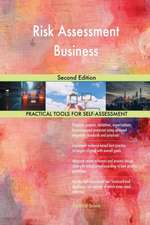The Economics of Crime: Lessons For and From Latin America: National Bureau of Economic Research Conference Report
Editat de Rafael Di Tella, Sebastian Edwards, Ernesto Schargrodskyen Limba Engleză Paperback – 21 iun 2012
Crime rates in Latin America are among the highest in the world, creating climates of fear and lawlessness in several countries. Despite this situation, there has been a lack of systematic effort to study crime in the region or the effectiveness of policies designed to tackle it. The Economics of Crime is a powerful corrective to this academic blind spot and makes an important contribution to the current debate on causes and solutions by applying lessons learned from recent developments in the economics of crime.
The Economics of Crime addresses a variety of topics, including the impact of kidnappings on investment, mandatory arrest laws, education in prisons, and the relationship between poverty and crime. Utilizining research from within and without Latin America, this book illustrates the broad range of approaches that have been efficacious in studying crime in both developing and developed nations. The Economics of Crime is a vital text for researchers, policymakers, and students of both crime and of Latin American economic policy.
Din seria National Bureau of Economic Research Conference Report
- 8%
 Preț: 536.74 lei
Preț: 536.74 lei - 5%
 Preț: 900.97 lei
Preț: 900.97 lei - 27%
 Preț: 751.40 lei
Preț: 751.40 lei - 9%
 Preț: 751.95 lei
Preț: 751.95 lei - 8%
 Preț: 535.23 lei
Preț: 535.23 lei - 9%
 Preț: 661.72 lei
Preț: 661.72 lei - 9%
 Preț: 777.88 lei
Preț: 777.88 lei - 9%
 Preț: 754.96 lei
Preț: 754.96 lei - 20%
 Preț: 737.44 lei
Preț: 737.44 lei -
 Preț: 350.32 lei
Preț: 350.32 lei - 27%
 Preț: 779.96 lei
Preț: 779.96 lei -
 Preț: 275.19 lei
Preț: 275.19 lei -
 Preț: 396.85 lei
Preț: 396.85 lei - 23%
 Preț: 672.20 lei
Preț: 672.20 lei - 23%
 Preț: 451.31 lei
Preț: 451.31 lei -
 Preț: 367.59 lei
Preț: 367.59 lei - 23%
 Preț: 598.34 lei
Preț: 598.34 lei - 23%
 Preț: 638.56 lei
Preț: 638.56 lei - 27%
 Preț: 715.19 lei
Preț: 715.19 lei - 23%
 Preț: 591.59 lei
Preț: 591.59 lei - 27%
 Preț: 717.44 lei
Preț: 717.44 lei - 27%
 Preț: 757.96 lei
Preț: 757.96 lei - 23%
 Preț: 556.65 lei
Preț: 556.65 lei - 27%
 Preț: 872.19 lei
Preț: 872.19 lei - 23%
 Preț: 616.34 lei
Preț: 616.34 lei - 27%
 Preț: 762.17 lei
Preț: 762.17 lei - 27%
 Preț: 802.94 lei
Preț: 802.94 lei - 27%
 Preț: 813.21 lei
Preț: 813.21 lei -
 Preț: 384.89 lei
Preț: 384.89 lei - 23%
 Preț: 454.11 lei
Preț: 454.11 lei - 27%
 Preț: 762.17 lei
Preț: 762.17 lei -
 Preț: 486.42 lei
Preț: 486.42 lei -
 Preț: 391.85 lei
Preț: 391.85 lei - 23%
 Preț: 629.08 lei
Preț: 629.08 lei - 20%
 Preț: 430.84 lei
Preț: 430.84 lei - 20%
 Preț: 368.22 lei
Preț: 368.22 lei - 22%
 Preț: 624.68 lei
Preț: 624.68 lei - 21%
 Preț: 424.17 lei
Preț: 424.17 lei - 15%
 Preț: 214.21 lei
Preț: 214.21 lei - 22%
 Preț: 614.43 lei
Preț: 614.43 lei - 20%
 Preț: 466.06 lei
Preț: 466.06 lei - 22%
 Preț: 552.54 lei
Preț: 552.54 lei - 15%
 Preț: 244.53 lei
Preț: 244.53 lei - 20%
 Preț: 494.56 lei
Preț: 494.56 lei - 21%
 Preț: 488.86 lei
Preț: 488.86 lei - 11%
 Preț: 301.72 lei
Preț: 301.72 lei - 21%
 Preț: 464.96 lei
Preț: 464.96 lei - 21%
 Preț: 378.58 lei
Preț: 378.58 lei
Preț: 623.75 lei
Preț vechi: 810.06 lei
-23% Nou
Puncte Express: 936
Preț estimativ în valută:
119.35€ • 124.61$ • 98.78£
119.35€ • 124.61$ • 98.78£
Carte tipărită la comandă
Livrare economică 04-18 aprilie
Preluare comenzi: 021 569.72.76
Specificații
ISBN-13: 9780226791852
ISBN-10: 0226791858
Pagini: 488
Ilustrații: 95 figures, 106 tables, 5 maps
Dimensiuni: 152 x 229 x 25 mm
Greutate: 0.71 kg
Editura: University of Chicago Press
Colecția University of Chicago Press
Seria National Bureau of Economic Research Conference Report
ISBN-10: 0226791858
Pagini: 488
Ilustrații: 95 figures, 106 tables, 5 maps
Dimensiuni: 152 x 229 x 25 mm
Greutate: 0.71 kg
Editura: University of Chicago Press
Colecția University of Chicago Press
Seria National Bureau of Economic Research Conference Report
Notă biografică
Rafael Di Tella is the Joseph C. Wilson Professor of Business Administration at Harvard Business School and a research associate of the NBER. Sebastian Edwards is the Henry Ford II Professor of International Economics at the Anderson Graduate School of Management, University of California, Los Angeles, and a research associate of the NBER. Ernesto Schargrodsky is professor and president of Universidad Torcuato Di Tella.
Cuprins
Acknowledgments
Introduction
Rafael Di Tella, Sebastian Edwards, and Ernesto Schargrodsky
I. Overview: Latin American Exceptionalism?
1. Understanding High Crime Rates in Latin America: The Role of Social and Policy Factors
Rodrigo R. Soares and Joana Naritomi
Comment: Alejandro Gaviria
II. The Economics of Crime Meets Latin America
2. Capital Crimes: Kidnappings and Corporate Investment in Colombia
Rony Pshisva and Gustavo A. Suarez
Comment: Juan Pantano
3. The Cost of Avoiding Crime: The Case of Bogotá
Alejandro Gaviria, Carlos Medina, Leonardo Morales, and Jairo Núñez
Comment: Alfredo Canavese
4. Do Conflicts Create Poverty Traps? Asset Losses and Recovery for Displaced Households in Colombia
Ana María Ibáñez and Andrés Moya
Comment: Martín González-Rozada
5. Crime Distribution and Victim Behavior during a Crime Wave
Rafael Di Tella, Sebastian Galiani, and Ernesto Schargrodsky
Comment: Lucas Ronconi
6. Assessing São Paulo’s Large Drop in Homicides: The Role of Demography and Policy Interventions
João M. P. de Mello and Alexandre Schneider
Comment: Lucas Llach
7. The Quality of Life in Prisons: Do Educational Programs Reduce In- Prison Conflicts?
María Laura Alzúa, Catherine Rodriguez, and Edgar Villa
Comment: Andrés Borenstein
III. International Evidence
8. What Do Economists Know about Crime?
Angela K. Dills, Jeffrey A. Miron, and Garrett Summers
Comment: Philip J. Cook
9. Peaceable Kingdoms and War Zones: Preemption, Ballistics, and Murder in Newark
Brendan O’Flaherty and Rajiv Sethi
Comment: Guillermo Cruces
10. Crime Displacement and Police Interventions: Evidence from London’s “Operation Theseus”
Mirko Draca, Stephen Machin, and Robert Witt
Comment: Catherine Rodriguez
11. The Impact of Incentives on Human Behavior: Can We Make It Disappear? The Case of the Death Penalty
Naci Mocan and Kaj Gittings
Comment: Lucía Quesada
12. Does Arrest Deter Violence? Comparing Experimental and Nonexperimental Evidence on Mandatory Arrest Laws
Radha Iyengar
Comment: Rafael Di Tella
Contributors
Author Index
Subject Index
Introduction
Rafael Di Tella, Sebastian Edwards, and Ernesto Schargrodsky
I. Overview: Latin American Exceptionalism?
1. Understanding High Crime Rates in Latin America: The Role of Social and Policy Factors
Rodrigo R. Soares and Joana Naritomi
Comment: Alejandro Gaviria
II. The Economics of Crime Meets Latin America
2. Capital Crimes: Kidnappings and Corporate Investment in Colombia
Rony Pshisva and Gustavo A. Suarez
Comment: Juan Pantano
3. The Cost of Avoiding Crime: The Case of Bogotá
Alejandro Gaviria, Carlos Medina, Leonardo Morales, and Jairo Núñez
Comment: Alfredo Canavese
4. Do Conflicts Create Poverty Traps? Asset Losses and Recovery for Displaced Households in Colombia
Ana María Ibáñez and Andrés Moya
Comment: Martín González-Rozada
5. Crime Distribution and Victim Behavior during a Crime Wave
Rafael Di Tella, Sebastian Galiani, and Ernesto Schargrodsky
Comment: Lucas Ronconi
6. Assessing São Paulo’s Large Drop in Homicides: The Role of Demography and Policy Interventions
João M. P. de Mello and Alexandre Schneider
Comment: Lucas Llach
7. The Quality of Life in Prisons: Do Educational Programs Reduce In- Prison Conflicts?
María Laura Alzúa, Catherine Rodriguez, and Edgar Villa
Comment: Andrés Borenstein
III. International Evidence
8. What Do Economists Know about Crime?
Angela K. Dills, Jeffrey A. Miron, and Garrett Summers
Comment: Philip J. Cook
9. Peaceable Kingdoms and War Zones: Preemption, Ballistics, and Murder in Newark
Brendan O’Flaherty and Rajiv Sethi
Comment: Guillermo Cruces
10. Crime Displacement and Police Interventions: Evidence from London’s “Operation Theseus”
Mirko Draca, Stephen Machin, and Robert Witt
Comment: Catherine Rodriguez
11. The Impact of Incentives on Human Behavior: Can We Make It Disappear? The Case of the Death Penalty
Naci Mocan and Kaj Gittings
Comment: Lucía Quesada
12. Does Arrest Deter Violence? Comparing Experimental and Nonexperimental Evidence on Mandatory Arrest Laws
Radha Iyengar
Comment: Rafael Di Tella
Contributors
Author Index
Subject Index





















